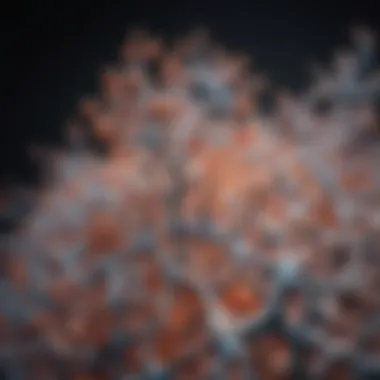Understanding Allergy Testing for Polyethylene Glycol


Intro
Polyethylene glycol (PEG) is a widely used compound in pharmaceuticals, cosmetics, and personal care products. It serves various functions including as a solvent, emulsifier, and thickening agent. Despite its common use, some individuals may develop allergies to PEG. Understanding the complexity of these allergies is integral for patient safety and effective management.
The necessity for allergy testing has grown as more products containing PEG are introduced into the market. Patients often find it difficult to determine if PEG is causing adverse reactions due to its ubiquitous nature. This article will explore the nuances of PEG allergies, the testing methodologies in place, and the broader implications for patient care.
Research Overview
Summary of Key Findings
Recent studies indicate a rising incidence of PEG allergies, particularly within certain demographic groups. Key findings suggest that the clinical manifestation of PEG allergies can vary significantly among patients. For example, while some experience mild irritations, others may face severe reactions such as anaphylaxis.
- Prevalence: PEG allergy is relatively uncommon, yet cases are increasing.
- Symptoms: Reactions can include skin rashes, gastrointestinal disturbances, and respiratory issues.
- Testing Necessity: Accurate testing methods are critical for proper diagnosis and management of PEG allergies.
Background and Context
Historically, PEG has been considered low-risk for allergic reactions. However, the increased use of PEG in various formulations has led to heightened awareness among medical practitioners. Understanding the biochemical properties of PEG is vital for recognizing potential allergic responses. Researchers have found that the molecular weight of PEG may influence its immunogenicity, which adds a layer of complexity in allergy testing.
The lack of standardized testing protocols creates challenges for healthcare providers. Many practitioners are still unaware of specific testing options available for PEG allergies. This gap highlights the need for targeted education and more robust research in this field.
Overview of Polyethylene Glycol
Polyethylene glycol, commonly referred to as PEG, is a versatile compound. It gained prominence in various industries due to its unique properties. This overview encapsulates the significance of PEG in both everyday and medical applications. Understanding PEG begins with grasping its definition and chemical structure, followed by its applications across multiple sectors.
Definition and Chemical Structure of PEG
Polyethylene glycol is a polymer formed through the polymerization of ethylene oxide. Its structure consists of repeating units of ethylene glycol, which contributes to its diverse characteristics. PEG varies in molecular weight, affecting its physical properties and usability. High molecular weight PEGs tend to be more viscous, while those with lower molecular weight are more fluid.
Chemically, PEG is classified as a polyether. This structure provides it with excellent solubility in both water and organic solvents. This solubility is fundamental in its applications, making PEG suitable for various formulations.
Applications of Polyethylene Glycol
The uses of polyethylene glycol are extensive, impacting many fields including medicine, cosmetics, and the food industry. Each of these areas demonstrates the compound's unique attributes and advantages.
Pharmaceutical Use
In pharmaceuticals, PEG is highly regarded for its ability to enhance drug solubility. Many medications utilize PEG as a carrier, facilitating improved absorption in the body. One key characteristic of PEG in this domain is its biocompatibility. It minimizes adverse reactions, making it a preferred choice. However, the variability in PEG molecular weights can lead to differences in efficacy or side effects.
Cosmetic Formulations
In cosmetics, PEG serves as an effective ingredient in various formulations. It acts primarily as a moisturizer due to its humectant properties. The ability to retain water is advantageous for skin hydration. PEG's greasy feel is considered advantageous in creams and lotions. Nonetheless, there are concerns regarding potential allergies or skin irritations. This aspect necessitates further exploration in the context of safety and consumer awareness.
Food Industry
The food industry also exploits polyethylene glycol for its emulsifying and thickening properties. It is often used in processed foods to enhance texture and stability. A significant characteristic of PEG here is its inertness, which means it does not react chemically with food components. While its use may offer benefits for food texture, debates continue regarding dietary safety and potential allergic reactions. Clear labeling and awareness are essential for consumer protection in this context.
Understanding Allergies Related to PEG
Understanding allergies related to polyethylene glycol (PEG) is crucial for both healthcare providers and patients. As PEG is widely used in various products, from pharmaceuticals to cosmetics, awareness of potential allergic reactions is essential for ensuring patient safety. Allergic reactions to PEG can range from mild to severe, making it important to recognize these reactions early. This section will cover the types of allergic reactions, their clinical manifestations, and the epidemiology of PEG allergies, providing a comprehensive foundation for further discussion and examination.


Types of Allergic Reactions
Immediate Hypersensitivity
Immediate hypersensitivity is a rapid allergic reaction that can occur upon exposure to PEG. This type of reaction typically happens within minutes to hours after contact. The primary characteristic of immediate hypersensitivity is the involvement of Immunoglobulin E (IgE) antibodies. These antibodies recognize the PEG as a threat, leading to the release of histamines and other inflammatory mediators.
This reaction is particularly significant in the context of PEG allergies, as it can lead to acute symptoms such as hives, itching, or even anaphylaxis in severe cases. One advantage of identifying immediate hypersensitivity is that it allows for quick interventions, which can be life-saving. However, the challenge lies in the fact that not all individuals demonstrate this hypersensitivity, which complicates diagnosis and management.
Delayed Hypersensitivity
Delayed hypersensitivity occurs hours to days after exposure to PEG. This reaction does not involve IgE antibodies but instead involves T-cells, which mount a more prolonged immune response. The key characteristic of delayed hypersensitivity is the slower onset of symptoms, which can include redness, swelling, and pain in the affected area.
This type of reaction is less well understood in the context of PEG allergy testing, but it remains important due to its recurrent nature. While immediate hypersensitivity may lead to rapid reactions, delayed hypersensitivity can manifest over time, leading to chronic conditions. The main advantage is the potential for ongoing monitoring and management, but it requires increased vigilance from both patients and providers.
Clinical Manifestations
Skin Reactions
Skin reactions are among the most common manifestations of PEG allergy. Patients may experience various symptoms, including rashes, eczema, or contact dermatitis. The characteristic feature of skin reactions is that they can arise not only with medical or cosmetic use but also with topical exposure. This makes recognizing skin symptoms vital for diagnosing PEG allergy.
Effective identification of skin reactions can help guide treatment and recommendations for preserving skin health. Due to the prevalence of PEG in personal care products, understanding the nature of these reactions helps clinicians offer appropriate alternatives or adjustments in continued treatment.
Respiratory Issues
Respiratory issues related to PEG allergy can range from mild nasal congestion to severe asthma attacks. The primary characteristic here is the sudden onset of respiratory distress, which can happen during or after exposure to PEG-containing products. This type of reaction can significantly impact a patient's quality of life.
Recognizing these symptoms early on is crucial in the context of medical treatment. Patients with respiratory issues need a clear understanding of warning signs and immediate procedures. However, establishing a direct causal relationship between PEG use and respiratory problems requires careful evaluation.
Anaphylactic Reactions
Anaphylactic reactions to PEG are rare but can be extremely serious. The key characteristic of anaphylaxis is the systemic response that can affect multiple organ systems. Symptoms can include difficulty breathing, swelling of the throat, rapid heartbeat, and severe gastrointestinal distress.
The life-threatening nature of anaphylaxis makes it a critical subject within PEG allergy discussions. Understanding the potential for such reactions can encourage patients and providers to take preventive measures seriously, including carrying emergency medications such as epinephrine. Early identification of those at risk is crucial, as prompt treatment is essential in such scenarios.
Epidemiology of PEG Allergy
The epidemiology of PEG allergy is an area of ongoing research. While reported incidents are relatively uncommon, there is increasing acknowledgment of sensitivity among certain populations, especially those with prior exposures to PEG-containing medications or products. Studies indicate that specific demographic factors, such as age and underlying health conditions, may contribute to higher susceptibility.
Understanding these patterns can inform future guidelines for safer PEG usage across industries. This knowledge is vital as it equips clinicians with the information necessary to advise patients accurately and to tailor approaches for managing potential risks associated with PEG exposure.
Methods of Allergy Testing for PEG
Understanding the methods for allergy testing related to polyethylene glycol (PEG) is crucial. As allergies to PEG can have serious repercussions, testing methodologies develop the foundation for diagnosing such conditions. Several testing approaches exist, each with unique benefits and considerations, and these contribute to patient safety and their management. Accurate testing leads to appropriate interventions, ensuring that both medical and cosmetic products do not cause adverse reactions in sensitive individuals.
Intradermal Testing
Intradermal testing involves injecting a small amount of PEG solution into the dermal layer of the skin to gauge allergic responses. This method is particularly beneficial due to its high sensitivity, which allows for the detection of even minor allergic reactions. It is commonly used when a patient has a suspected allergy but has not reacted strongly prior to testing.
However, intradermal testing has some considerations. A positive reaction may not always indicate a clinically relevant allergy. Therefore, results must be interpreted carefully. Healthcare professionals must consider the patient's history alongside test outcomes. Moreover, because this method is invasive, there is risk of complications, such as local irritation or infection. Despite the drawbacks, intradermal testing remains a valuable tool in allergy diagnostics.


Patch Testing
Patch testing is another important method used in evaluating PEG allergies, primarily targeting delayed-type hypersensitivity reactions. In this approach, small amounts of PEG are applied to patches which are then placed on the skin for a designated period, typically 48 hours. After two days, the patches are removed, and skin responses are assessed.
This technique allows for a thorough investigation of allergic reactions that may not be apparent through immediate testing. It is particularly relevant for individuals experiencing chronic dermatitis believed to be triggered by PEG. The simplicity of the application, alongside its non-invasive nature, makes patch testing a practical choice for both patients and healthcare providers.
Nevertheless, it is important to consider that patch testing requires that patients refrain from using topical medications prior to the assessments. This preparation can sometimes lead to variables affecting patient experience and results. Therefore, clear communication regarding these restrictions is essential to obtain reliable data from patch testing.
Serological Studies
Serological studies represent an evolving area of allergy testing, focusing on detecting specific immunoglobulin E (IgE) antibodies against PEG in the bloodstream. This method offers a convenient and non-invasive alternative to traditional skin tests. Patients can undergo blood draws without needing to apply substances directly to their skin, which is beneficial for those with severe skin conditions.
While serological studies provide valuable insights, there are limitations. The specificity of PEG IgE tests can vary and may result in false positives. This variability necessitates careful interpretation of results by healthcare providers who must correlate them with clinical histories and other test results.
Challenges in PEG Allergy Testing
The subject of challenges in polyethylene glycol (PEG) allergy testing is crucial, particularly for accurate diagnosis and effective patient management. As awareness of PEG allergies grows among healthcare professionals and patients, understanding the complexities of testing methods is vital. Different challenges may arise from the varying individual responses to PEG and the methods used for testing. This section discusses these challenges in detail, emphasizing the implications for clinical practice.
Varying Sensitivity and Specificity
Assessment of PEG allergies is complicated by the sensitivity and specificity of various testing methods. Sensitivity refers to the ability of a test to correctly identify individuals who have an allergy, while specificity indicates how well the test identifies those who do not.
Recent studies show that skin tests often yield high sensitivity but may lack specificity. A false positive result could occur, leading to unnecessary avoidance of PEG-containing products. Conversely, a false negative could result in exposure to an allergen, potentially causing serious reactions. Some individuals may react to PEG in a way that does not fit typical patterns detected by current tests, contributing to discrepancies.
Developing better testing methodologies that enhance both the sensitivity and specificity of PEG allergy tests is essential for accurate diagnoses and improving patient outcomes.
Standardization of Testing Protocols
The absence of standardized testing protocols is another notable challenge in PEG allergy testing. Various laboratories utilize different procedures, which can yield inconsistent results. This inconsistency complicates the comparison of findings across studies and diminishes the reliability of clinical guidelines.
For instance, patch testing and intradermal testing protocols may vary from one facility to another. Such variations can be based on:
- Concentration of PEG used in tests
- Duration of exposure
- Patient demographics
Inconsistencies can lead to confusion among practitioners and patients alike, making it difficult to establish any consensus on effective management strategies for PEG allergies.
Efforts to standardize testing protocols may include:
- Establishing clear guidelines for concentrations and methodologies.
- Collaborating with immunology societies to create universally accepted protocols.
- Promoting training and resources to educate healthcare providers about these strategies.
Maintaining reliable and standardized protocols will significantly enhance the accuracy of PEG allergy testing, ultimately leading to better patient care.
Clinical Implications of PEG Allergy Testing
Understanding the clinical implications of polyethylene glycol (PEG) allergy testing is essential in managing patient health. PEG is a compound frequently used in medications, cosmetics, and even food products. Therefore, its allergy testing has far-reaching consequences for those exposed. It is crucial to recognize how accurate testing can aid in diagnosis, treatment strategies, and overall patient management. The ramifications of a PEG allergy can range from mild skin reactions to severe anaphylaxis. By establishing clear guidelines for testing, healthcare providers can ensure better patient outcomes.
Treatment Strategies for Allergic Reactions
When someone displays adverse reactions to PEG, it is important to have efficient treatment strategies ready. The approach usually depends on the severity of the symptoms.


- Mild Reactions: For mild symptoms, like localized skin irritation, antihistamines such as diphenhydramine might be enough. This is often sufficient as an initial response to manage discomfort.
- Moderate Reactions: If the person exhibits more serious symptoms, such as rashes or gastrointestinal issues, corticosteroids can help reduce inflammation. A healthcare provider should prescribe these medications based on the individual's condition.
- Severe Reactions: In cases of anaphylaxis, immediate medical attention is critical. Epinephrine auto-injectors, like EpiPen, should be used without delay. Patients must also receive further evaluation and possibly hospitalization to monitor their condition.
Doctors must educate patients on recognizing their own symptoms and when to seek help. Establishing an action plan is fundamental for anyone with a known PEG allergy. It can significantly improve a patient’s quality of life and safety.
Patient Education and Management
Effective patient education is another cornerstone in managing PEG allergies. Patients should be informed about their allergic responses, understanding how to identify potential sources of PEG exposure. This may include examining ingredients in both over-the-counter and prescription products.
- Resource Utilization: Patients can benefit from using resources and databases to identify PEG-containing products. Websites like Wikipedia and anti-allergy forums on Reddit may prove beneficial.
- Preventive Strategies: Educating patients on avoiding products containing PEG is critical. This can include reading labels carefully and asking healthcare providers for alternatives when needed.
- Regular Follow-ups: Ongoing discussions with healthcare providers lead to better management. Scheduled check-ups enable updates on patient status, allowing for adjustments in treatment if necessary.
Patients must feel empowered to communicate their needs effectively. This involves fostering a supportive relationship between healthcare providers and patients, ensuring that treatment plans reflect the patient’s individual circumstances.
"Effective communication is essential in ensuring both the patient and provider are aligned in the allergy management approach."
In summary, the clinical implications of PEG allergy testing impact not only the immediate treatment response but also the long-term management and quality of life for those affected. By focusing on targeted treatment strategies and robust patient education, the health community can enhance how PEG allergies are managed in clinical settings.
Future Directions in Research
Research into polyethylene glycol (PEG) allergies is crucial, especially given the compound's prevalence in various products. Understanding the future directions in research helps address gaps in current knowledge and improves testing accuracy.
Emerging Guidelines for Testing
Emerging guidelines focus on creating standardized protocols for PEG allergy testing. Researchers emphasize the need for comprehensive clinical trials. The aim is to establish reliable methods for intradermal and patch testing. Guidelines can ensure consistency across practices, making them effective for widespread clinical use. Vital benchmarks for sensitivity and specificity will guide practitioners in determining the likelihood of a true allergic response.
Potential Alternatives to PEG in Products
The search for alternatives is essential. Polyethylene glycol has been a staple in many formulations, but its potential to cause allergic reactions necessitates finding substitutes. Options might include different synthetic polymers or naturally derived compounds. For instance, alternatives like glycerin and sorbitol could be less allergenic. Ongoing research will likely investigate these compounds’ biochemical properties, evaluating their effectiveness in lieu of PEG. Transitioning to these alternatives could significantly reduce allergy incidence.
Long-term Follow-up Studies
Long-term follow-up studies are important for understanding the duration and nature of allergic reactions. Monitoring individuals over time can provide data on the persistence of PEG allergies. Assessing cross-reactivity with other substances can also be valuable. Such studies will help refine diagnostic approaches and treatment strategies, ensuring they align with evolving understandings of PEG allergies. Importantly, integrating patient feedback from these studies will ensure that healthcare providers address concerns effectively.
In summary, enhancing research on PEG allergies will improve testing methods, offer alternative solutions, and provide insights from long-term studies.
Expanding research efforts in these areas will ultimately lead to better management of PEG-related allergies, significantly benefiting affected patients.
Concluding Remarks
The importance of concluding remarks in this article cannot be understated. This section serves as the capstone of the discussion surrounding polyethylene glycol (PEG) allergy testing, summarizing key findings and emphasizing their implications. The comprehensive overview presented highlights the complexity of PEG allergies, as well as the associated testing methodologies and clinical ramifications. Understanding these elements is critical not only for medical professionals but also for patients who might be affected by PEG in various products.
In summary, the exploration of PEG allergies reveals that allergic reactions can vary significantly among individuals, necessitating tailored approaches in testing and diagnosis. Moreover, recognizing the spectrum of allergic manifestations—from skin reactions to more severe respiratory issues—enables healthcare providers to develop effective management strategies. It is essential to take into consideration the nuances of each patient's history and exposure to PEG-containing products.
Furthermore, the landscape of PEG allergy research is still evolving. Future directions in research will likely refine existing testing protocols and unveil potential alternatives to PEG that could offer safe, hypoallergenic options in both pharmaceuticals and cosmetics. Addressing these considerations can enhance patient outcomes and advance our understanding of non-IgE mediated hypersensitive reactions.
Ultimately, continued focus on PEG allergies and robust research in this area will foster greater awareness and lead to improved patient education. A collaborative effort between researchers, practitioners, and patients is essential in mitigating the risks associated with PEG exposure and ensuring safe product development.
Summary of Key Points
- Polyethylene glycol (PEG) can cause allergic reactions, varying in severity among individuals.
- Testing methods include intradermal, patch testing, and serological studies, each with its unique challenges.
- Understanding the spectrum of allergic reactions and clinical manifestations aids in patient management.
- Emerging research can lead to improved testing protocols and alternative materials, enhancing patient safety.
The Importance of Continued Research
The field concerning PEG allergies and their testing is rife with opportunity for future exploration. Continued research is vital for several reasons:
- Improving Testing Accuracy: Current testing methods may not capture all cases of PEG allergy. Further research can refine testing protocols to improve sensitivity and specificity.
- Identifying Alternatives: Investigating alternatives to PEG for use in products may provide solutions for allergic individuals. This demand for safer ingredients continues to grow.
- Longitudinal Studies: Ongoing follow-up studies can provide insights into long-term effects of PEG exposure and the stability of allergic reactions over time.
- Patient Education: Research outcomes can enhance educational materials, empowering patients to make informed decisions about their product choices and management strategies.







